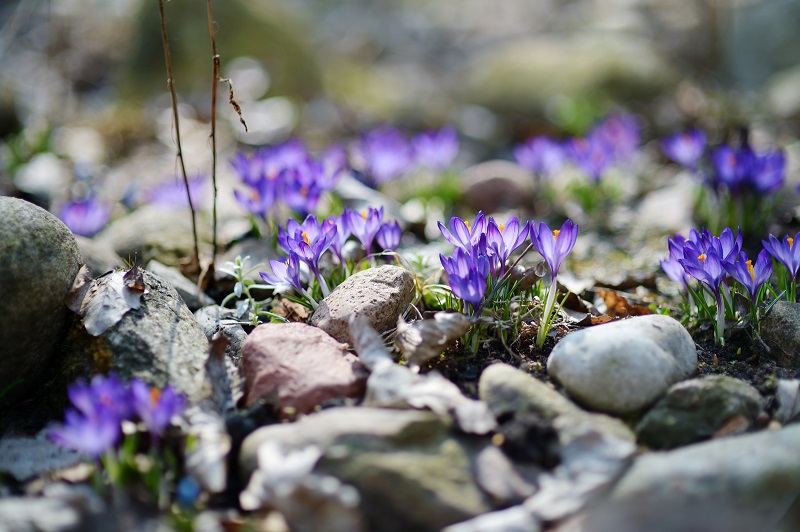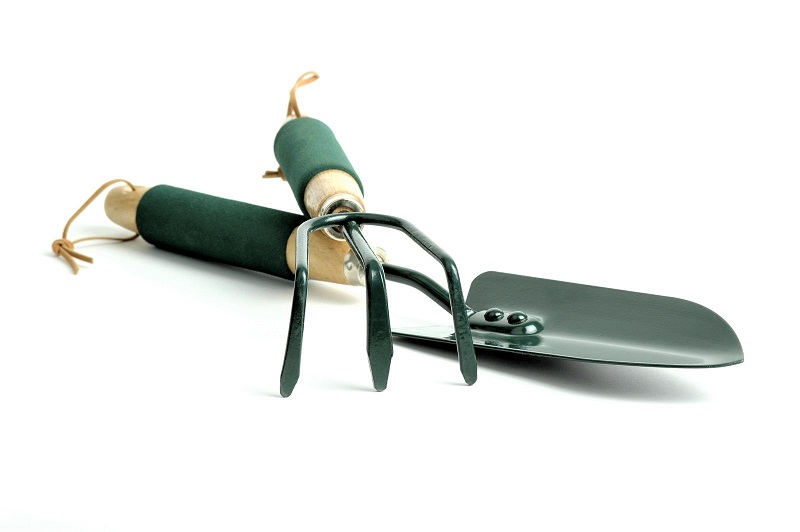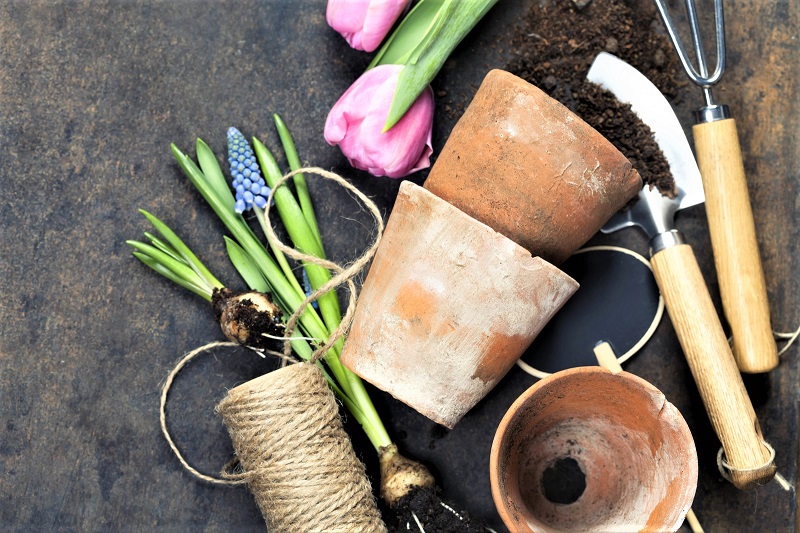Last Updated on April 17, 2021 by teamobn
Have you been out to check on your vegetable patch yet? Many gardening novices think the growing season doesn’t start until April or May. That’s not true.
You can start preparing your garden and planting seeds much earlier. In fact, the experienced gardener will tell you that it’s always best to get a head start.
Early spring is the time to tidy your vegetable patch, prepare the soil, and lay down some mulch. If you start the right crops now, too, you’ll be harvesting fresh vegetables by April or May!

Now is the time to spring into action!
Contents
While spring might not be in full bloom yet, our gardens are even now starting to wake up. You may have already noticed frogspawn lacing the ponds and crocuses poking through the grass. Now is the perfect time to start getting busy outdoors.
Below are basic tasks to start this year’s growing season.
Get your tools and supplies in order.
Head out to the shed and give your tools a once over. Sharpen blades, oil hinges, and consider expanding or improving your collection. Use a mill file to sharpen blades, then add penetrating oil to remove and prevent corrosion.
You’d be surprised by how much easier it is to dig or cut with a sharp, well-oiled implement. A well-maintained set of garden tools can make the time you spend in the garden so much more productive.
You should also take this opportunity to replenish your garden supplies. Make sure you have enough fertilizer and soil amendments. Re-stock your supply of plant supports, and pre-assemble any garden structures like tomato cages or trellises.
Get this work done in your shed now while the weather is still cold. Then you won’t have to worry about any of it later when there are other things you’d rather be doing outside.

Top-up your containers.
If the soil in your containers and raised beds have slumped over winter, it’s time to add a revitalizing top-up. Start by removing any weeds from the container then add some compost to your planting medium.
Be careful not to fill your containers to the brim, though. You need to leave some space for watering. A top layer of good mulch will hold soil in place and discourage weeds.

Start weeding.
Now is also the time to start weeding your vegetable patch. Weeds can grow in a variety of places. Where they grow in your garden determines how you should control and prevent them.
Often enough, weeds will start in bare patches of soil in the borders of the garden. Where possible, you should start planning to fill any gaps with companion crops to prevent weeds from overrunning the space.
You can remove smaller clumps of weeds from borders by hand or with a hoe. Remember to break off the tops of the roots so they do not have a chance to spread more seed!
You do not need to break-up the soil very deep. Most of the time, you’ll do better by keeping to less than 12 inches.

Prepare the soil for planting.
Depending on where you live, the soil might already be workable. If so, you can begin preparing your vegetable beds. Soil tends to compress during winter, so the first thing to do is loosen it by tilling or turning it.
You can use a power tiller to work on larger areas. There are countless good, inexpensive tillers out there if you’re looking to buy one. A quick browser search should help you find the one that’s right for your garden. Below are five types you might need to consider.
Cultivators. These machines are relatively lightweight and affordable. They are good for stirring soil. But, unlike larger, more powerful garden tillers, cultivators aren’t as useful for breaking new ground.
Garden Tillers. Garden tillers are larger machines with enough power to break ground. They are also useful for stirring soil and plowing. They come in a range of sizes, power levels, and costs.
Front-tine tillers. Front-tine tillers have tines located under the engine in front of the wheels. They’re more powerful than cultivators but less powerful than other types of garden tillers. Their design makes them easy to maneuver. This is great advantage in gardens with narrow rows.
Rear-Tine Tillers. These are your more powerful option. If you’re breaking ground on a new garden, especially if you have tough soil, this type of tiller will make the job manageable. These tillers have large wheels with tines located on the back of the machine.
Vertical-Tine Tillers. Not nearly as common as any of the other tiller types mentioned here, vertical-tine tillers are a relatively new technology. They have tines that cut forward through the soil, rather than downward like front and rear-tine models. That makes them faster and easier to use.
Whether you’re using a tiller or a garden fork, work the soil to a depth of about 12 inches. You can – and should –mix any mulch or well-composted leaf litter into the soil, as well.

Add compost and soil amendments to your patch.
Once you’re done turning the soil, you can start adding compost and amendments to your vegetable patch. Use a soil test kit to determine the soil’s pH and nutrient levels. The test will tell you what type of organic materials the soil needs.
This step is especially important if you have poor or clay-based soil. If that’s the case you’ll need a healthy layer of compost to improve the soil’s texture, nutrient content, and moisture-retention.
Organic fertilizers are now more widely available. These have higher concentrations of nutrients than in the past, making them easy-to-use alternatives to chemical fertilizers.
Once you’ve applied the fertilizer, you should your garden patch level and water it lightly. This will help the soil settle and release air pockets.
You can also mulch the bare soil with a thick layer of bark chippings or manure to prevent weeds from germinating.
Start your early spring vegetables.
The cold of early spring offers an excellent opportunity to start some choice vegetables, too. Many plants can be started indoors in trays this time of year. You can then plant them outside later in the season. These include onions, potatoes, and artichokes, among others.
But then there are also vegetables you can put into the ground right now! These crops will go from seed to harvest well before the summer temperatures soar. Here are four delicious, easy-to-grow vegetables that thrive in the cool weather of early spring.
Snow Peas. Like their shell and sugar snap cousins, snow peas are cold-weather veggies best planted the moment the soil can be worked every spring. They germinate best when soil temperatures are between 10°C and 15.5°C. The plants shrug off spring frosts like a champ!
Carrots. Carrots are grown as a cool-season crop. This means you can begin sowing seeds when soil temperatures reach about 10°C in the early spring.
Use a good soil thermometer to ensure optimum planting temperatures. These handy gadgets are fairly inexpensive and you can purchase them from any nearby garden center.
Carrot seeds will typically start germinating when the soil reaches 13°C to 24°C. You can start harvesting carrots in as little as 50 to 100 days after planting, too.
Lettuce. This is among the easiest early spring veggies. While you can purchase starter plants from your local nursery, it’s far less expensive – and easier – to start lettuce from seed. You can sow lettuce seeds directly into the garden as early as eight weeks before the last expected spring frost.
Radish. This is another spring vegetable well-worth growing, especially because homegrown roots taste so much sweeter than store-bought radishes.
For good root formation, you should plant radish in early spring, when temperatures are cool. They will be ready to harvest in just three to five weeks. Trust us, homegrown radish seldom disappoints!
Be prepared for late spring frosts!
If you garden in a climate where late spring frosts are a possibility, be prepared to protect tender emerging buds. You can use old sheets and towels to cover them. High-quality row covers are likewise available online.
Do not cover tender plants with plastic sheets or tarps. Plastic will only serve to increase the cold’s effect rather than mitigate it.
That said, there is no need to cover your vegetable patch if buds haven’t emerged yet.










